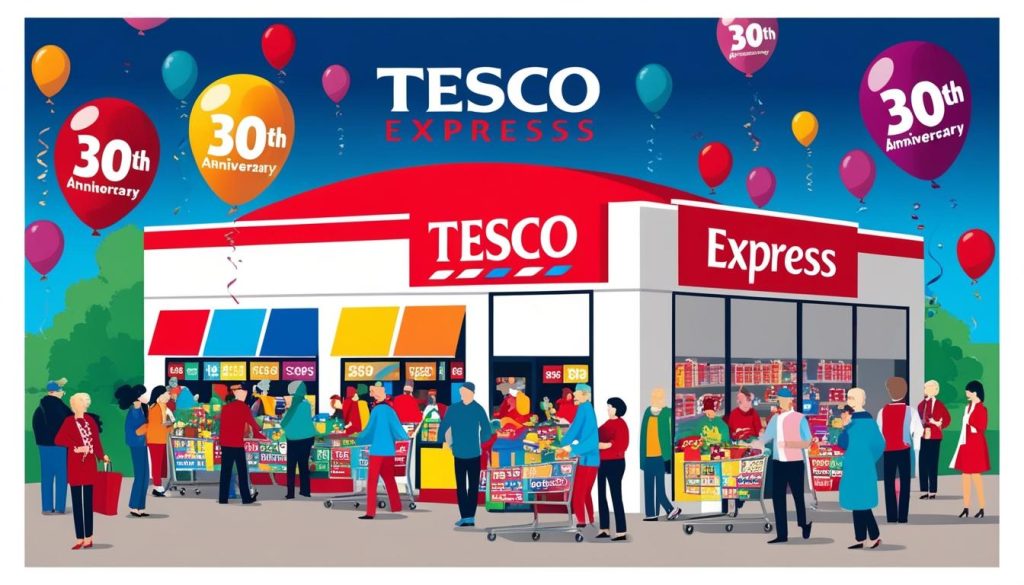Tesco reveals ambitious expansion strategy with 150 new stores, celebrating 30 years of Tesco Express amid ongoing challenges in pricing and competition.
Tesco has recently announced plans to significantly expand its presence in the UK by opening 150 new convenience stores over the next three years. This initiative coincides with the 30th anniversary of its Tesco Express brand, which began its operations in 1994 with the opening of its first store in Barnes and Norbury, London. Today, Tesco boasts over 4,000 grocery stores across the nation, and the recent announcement marks a pivotal move in response to consumer demand for more accessible shopping options.
The most recent addition to the Tesco Express network was opened in Burnt Oak, a location of historical significance as it is near the site of the first-ever Tesco store, founded by Jack Cohen in 1929. Kevin Tindall, managing director of UK stores at Tesco, expressed satisfaction with this return to origins, noting Burnt Oak’s special place in the company’s history and its commitment to serving the local community once again.
In keeping with the trend seen among other supermarket chains, Tesco has placed increased emphasis on its convenience stores over the past year, implementing a series of price cuts across a variety of essential items. Recently, the supermarket announced reductions on approximately 200 lines within its Express outlets, with an average price drop of 10%. Notable price adjustments include a four-pint bottle of milk now priced at £1.45, 300g chicken breast portions reduced by 25p to £2.25, and a 200g jar of Tesco Gold Instant Coffee, which has also been slashed by 25p to £2.25. Additionally, branded items have seen price reductions, such as Warburton’s White Sliced Sandwich Rolls, which are now £1.20 for a six-pack, down from their previous price.
Despite these efforts, the issue of pricing disparity between full-sized stores and convenience outlets remains pertinent. A campaign led by the consumer group Which? highlighted that shoppers at smaller stores often face higher prices compared to larger grocery locations. A study released in September found that products at convenience stores could be up to 20% more expensive than their full-sized counterparts. Specifically, Tesco customers may experience a 10% price difference, while Clubcard holders face an 11% premium at convenience stores compared to larger Tesco outlets. In defence of their pricing structure, Tesco cited the elevated operating costs associated with city and town centre locations, which include higher rent and rates.
As Tesco moves forward with its expansion plans, the supermarket chain appears to be responding strategically to market conditions and consumer trends, all while grappling with ongoing challenges related to pricing and competition within the retail sector.
Source: Noah Wire Services
- https://www.betterretailing.com/150-new-tesco-express-stores-to-open/ – Corroborates Tesco’s plan to open 150 new Express stores over the next three years and the expansion of its convenience store format.
- https://ground.news/article/tesco-plans-to-open-150-new-convenience-stores-creating-2-000-new-jobs – Supports the announcement of Tesco’s plan to open 150 new convenience stores and the creation of new jobs.
- https://www.talkingretail.com/news/industry-news/tescos-rapid-c-store-expansion-continues-25-11-2024/ – Confirms Tesco’s rapid expansion of its Express stores and the ongoing battle for convenience spending.
- https://www.grocerygazette.co.uk/2024/11/21/tesco-price-cuts-express/ – Details the recent price cuts on over 200 lines in Tesco Express stores, including specific price reductions on essential items.
- https://www.kamcity.com/namnews/uk-and-ireland/convenience/tesco-planning-to-open-150-new-convenience-stores/ – Mentions Tesco’s plans to open new convenience stores and other initiatives such as price cuts in these stores.
- https://www.betterretailing.com/150-new-tesco-express-stores-to-open/ – Provides context on Tesco’s overall expansion strategy, including the addition of new superstores and Jack’s discounters.
- https://ground.news/article/tesco-plans-to-open-150-new-convenience-stores-creating-2-000-new-jobs – Highlights the job creation aspect of the new convenience store openings.
- https://www.grocerygazette.co.uk/2024/11/21/tesco-price-cuts-express/ – Quotes Tesco’s chief executive, Ken Murphy, on the commitment to offering great value through price cuts in Express stores.
- https://www.talkingretail.com/news/industry-news/tescos-rapid-c-store-expansion-continues-25-11-2024/ – Discusses the strategic response of Tesco to market conditions and consumer trends through its convenience store expansion.
- https://www.grocerygazette.co.uk/2024/11/21/tesco-price-cuts-express/ – Mentions the addition of new cosmetics lines to Tesco.com, which aligns with the broader strategy of enhancing convenience and value.
- https://www.betterretailing.com/150-new-tesco-express-stores-to-open/ – Addresses the issue of pricing disparity between full-sized stores and convenience outlets, citing higher operating costs.


